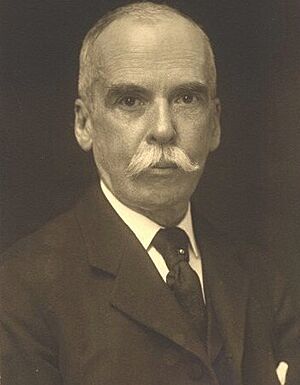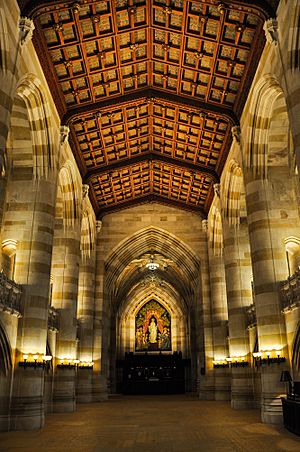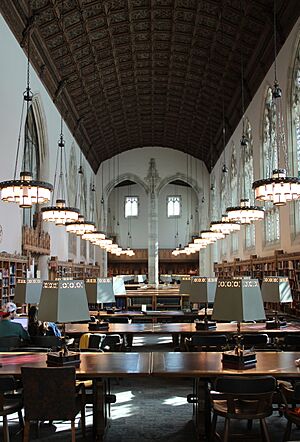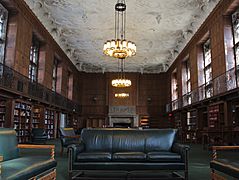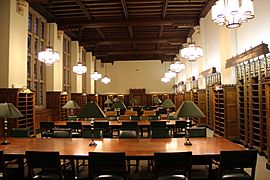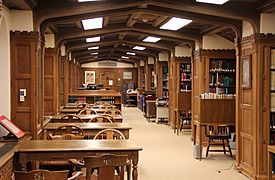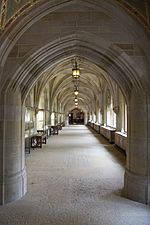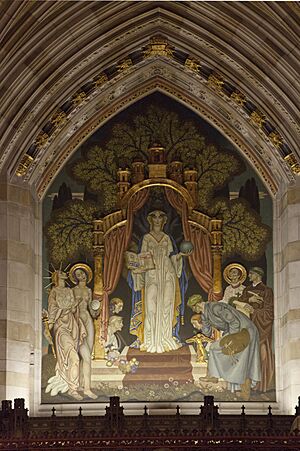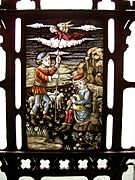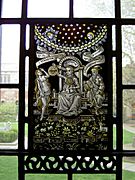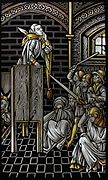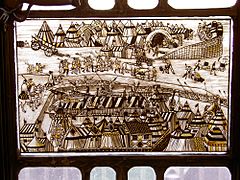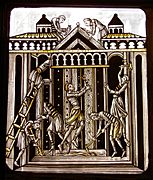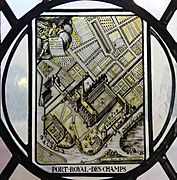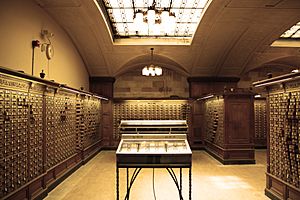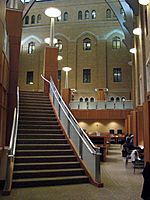Sterling Memorial Library facts for kids
Quick facts for kids Sterling Memorial Library |
|
|---|---|
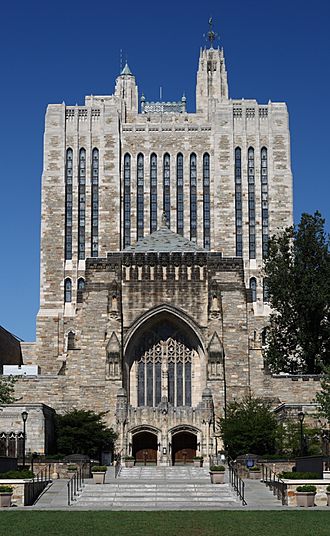
Facade and tower of Sterling Memorial Library
|
|
| General information | |
| Type | Library |
| Architectural style | Collegiate Gothic |
| Address | 120 High Street |
| Town or city | New Haven, Connecticut |
| Country | United States |
| Coordinates | 41°18′41″N 72°55′45″W / 41.3113°N 72.9291°W |
| Completed | 1930 |
| Opened | April 1931 |
| Cost | $8 million |
| Owner | Yale University |
| Height | 150 feet (46 m) |
| Technical details | |
| Floor count | 16 |
| Floor area | 441,651 square feet (41,030.7 m2) |
| Design and construction | |
| Architect | James Gamble Rogers |
The Sterling Memorial Library (often called SML) is the main library building at Yale University in New Haven, Connecticut. It opened in 1931. The famous architect James Gamble Rogers designed it. He wanted it to be the most important building on Yale's campus, which is known for its Gothic Revival style.
The library's tall tower has sixteen floors filled with books. It holds over 4 million books! Many special collections are also kept here. For example, Yale's important old papers and documents are stored in the building. The library even connects to the underground Bass Library through a tunnel. This adds another 150,000 books to the collection.
The library is named after John W. Sterling. He was a lawyer who left a lot of money to Yale. He wanted a "useful and architecturally beautiful" building to be built. Sterling Library is very fancy. It has lots of sculptures, paintings, and hundreds of stained glass windows. These were made by an artist named G. Owen Bonawit. Besides the book tower, the library has five large reading rooms. It also has two courtyards. One of these is now a music library.
You can take tours to see the library's main entrance hall and reading rooms. However, only people with a special library card can use the collections.
Contents
History of the Library
Before Sterling Memorial Library was built, Yale's books were in a smaller building. It was called the College Library. This old library was built in the 1840s for only 40,000 books. But Yale's collection grew to over one million books! The old building just wasn't big enough anymore.
In 1918, Yale received a huge gift of $17 million from John W. Sterling. He was a lawyer from New York. This was the largest gift ever given to an American university at that time. Sterling wanted Yale to build "at least one enduring, useful and architecturally beautiful edifice." Because the book collection was so big, the university decided to use Sterling's gift to build a new, much larger library. It would hold 3.5 million books.
The first architect for the library was Bertram Goodhue. He planned for the books to be in a tall tower. But Goodhue passed away in 1924. So, the project went to James Gamble Rogers. He was already helping Yale plan its campus. Rogers decided to make the library look like a grand cathedral. He wanted it to be "as near to modern Gothic as we dared to make it." The entrance hall looks like a church's main aisle, called a nave. He also ordered lots of stained glass and stone decorations.
The library is very big. It takes up more than half a city block. Twenty buildings had to be moved to make space for it. Construction started in 1927.
While the new library was being built, Yale asked its former students for more book donations. By 1931, the library had almost 2 million books. Many were rare books and old papers. One very important gift was a Gutenberg Bible. This was given by Anna Harkness. It became the main treasure in the new Rare Book Room. Here, students could see the university's most valuable books for the first time.
Some people at the time thought the new library was too expensive. They also thought its old-fashioned style was not modern enough. But today, many people admire its grand design and how useful it is.
Inside the Building
The library is located in the middle of Yale's campus, called Cross Campus. Other buildings around it were also designed by Rogers. They are all in the same Gothic Revival style.
The main entrance hall of the library is called the "nave." It looks like the main aisle of a large church or cathedral. At the far end is a fancy desk where you can check out books. There's also a large painting above it by Eugene Savage. The nave is made of stone blocks. It doesn't have steel inside like other parts of the library. It's decorated with stone carvings, wood, metalwork, and stained glass windows.
The main hall has two side aisles. These used to hold the old paper card catalogs for all the books. Now, the cards are gone. These aisles are used as seating areas and a computer lab.
The Tower: Where the Books Are
The library's tall tower holds fifteen floors of books. This part is often called the "Stacks." It was built to hold 3.5 million books. It's a seven-story building with eight smaller floors in between. Even though it looks Gothic on the outside, the tower has a strong steel frame inside. This allows it to be very tall. The top of the tower looks like a castle.
If you put all the shelves in the tower end-to-end, they would stretch for about 80 miles (130 km)! The tower also has study rooms, offices, and special collections. One interesting collection is the Yale Babylonian Collection. Only people connected to the university can go into the Stacks.
Reading Rooms: Places to Study
There are four main reading rooms near the nave on the first floor:
- Starr Reading Room: This is the main reading room. It's designed like a large dining hall from an old monastery. It has a curved ceiling, tall windows, and wooden bookshelves.
- Periodical Reading Room: This room is for magazines and journals. It has windows with zodiac signs on them. These signs represent how magazines come out regularly.
- Linonia and Brothers Reading Room: This room is for casual reading. It used to be only for men, like a "gentlemen's club." But since the 1960s, it's been open to everyone. It holds about 20,000 books.
- Franke Family Reading Room: This room used to hold books that were used very often. Now, it's another place to read magazines.
The Wing: Special Collections
The northern part of the library, called the "wing," has offices and three important rooms. You get there through a hallway that looks like a cloister (a covered walkway). There's a lecture hall and the Memorabilia Room. The Memorabilia Room shows temporary exhibits about Yale's history.
The Rare Book Room was designed to let people look at Yale's collection of old and valuable books. There's even a special round room behind it that was built to hold a Gutenberg Bible. In 1963, the Beinecke Rare Book & Manuscript Library was built. It's a safer place for rare books. So, the old Rare Book Room and its chapel are now used by the library's Manuscripts & Archives department.
The Courtyard: Music Library
The library originally had two courtyards with gardens. In 1997, one of them was covered and turned into the Irving S. Gilmore Music Library. The other courtyard, called the Selin Courtyard, has designs that show the history of printing.
Decorations and Art
The Sterling Memorial Library is one of the most decorated buildings at Yale. James Gamble Rogers hired many talented artists. These included G. Owen Bonawit for stained glass, Samuel Yellin for metalwork, René Paul Chambellan for sculptures, and Eugene Savage for paintings. The outside of the building has stone gargoyles, carvings, and words. The nave is the most decorated inside, but you can find beautiful stained-glass windows in almost every room.
Entrance Relief: Stories in Stone
Above the library's main entrance, there is a large stone carving. It shows the learning achievements of ancient civilizations. It was made by René Paul Chambellan. The carving shows scholars from ancient Egypt, Assyria, Greece, China, and other cultures. In the middle, there's a medieval scholar. Above the doors, you can see symbols of different civilizations. These include a Phoenician ship and the Capitoline wolf of ancient Rome.
Alma Mater Mural: The Spirit of Learning
At the far end of the nave, there is a large painting by Eugene Savage. He was a professor at the Yale School of Art. The painting is called "The Imagination that Directs the University's Spiritual and Intellectual Efforts." But most people call it the Alma Mater mural. It shows a person representing the "University." Around her are figures that stand for different school subjects.
Stained Glass: Colorful Stories
There are 680 unique stained glass panels in the library. They were made by G. Owen Bonawit. You can find them in the nave, reading rooms, offices, and the tower. Eighty panels in the nave show scenes from the history of Yale and New Haven. Most reading rooms have stained glass that matches their subject. For example, a history reading room might have panels about famous historical events.
Other Cool Decorations
In the nave, there are ten stone panels by Chambellan. They show the history of the Yale University Library. The ceiling of the nave has carvings of writing tools. Samuel Yellin, a blacksmith, made the iron elevator doors for the book tower. These doors show different jobs and crafts. He also made other metalwork and gates for the building.
You can find other stone carvings by Chambellan all over the building. These include gargoyles and other figures. Many of his works show learning and university life. But some are funny and show students or librarians in a humorous way.
The library also honors important Yale graduates. A picture of Edward Bouchet, one of Yale's first African American graduates, is in the nave. Near the Franke Family Reading Room, there's a statue of Yung Wing. He was the first Chinese person to graduate from Yale. In 2016, a painting of the first seven women to get Ph.D.s from Yale was placed in the library. This was the first painting in the library to feature women.
Library Collections
Book Catalog: Finding Books
Most of the books in Sterling Library are kept in the tower, in the "Stacks." The library uses two ways to organize books. One is the Yale Library system, which is older. The other is the Library of Congress system, which is more common. Even though the Library of Congress system started in 1970, many older books are still organized by the Yale system.
The old paper card catalogs in the nave used to have millions of cards! Now, you use a computer to find books.
Manuscripts & Archives: Old Papers and More
This department is where Yale keeps its most important old papers. It has Yale's history, old letters, and personal papers given to the university. The old Rare Book Room is used as its main reading room. But most of the collection is stored in another location. Some important items here include papers from Charles Lindbergh (the pilot) and Osama bin Laden's audio library. There are also many papers from important diplomats.
Music Library: Sounds and Scores
Books, recordings, and other materials about music are in the Irving S. Gilmore Music Library. This library was created from one of Sterling's old courtyards. It has one of the biggest collections of music recordings and scores in the United States. It includes papers from famous composers like Charles Ives.
Film Archive: Movies and Videos
The Yale Film Archive is on the seventh floor of the library. It has over 7,000 film items. These include old movie prints and original negatives. It also has over 50,000 videos that you can check out. The archive collects, saves, and shows films.
Other Special Collections
Besides the main collection, the library has several other special collections:
- The Yale Babylonian Collection: This is the largest collection of ancient Babylonian cuneiform writing (wedge-shaped writing on clay tablets) in North America.
- The Map Collection: This collection has over 200,000 printed maps. It also has digital map data.
- Arts of the Book: This collection has materials about printing, bookbinding, and graphic design.
Major Projects: Important Research
The library also hosts several big research projects:
- The Benjamin Franklin Papers: This project collects and publishes all the papers of Benjamin Franklin.
- The Fortunoff Video Archive for Holocaust Testimonies: This is a collection of about 4,500 video recordings. They are stories from people who witnessed or survived the Holocaust.
- Boswell Editions: This project edits and publishes the papers of James Boswell. He was a famous writer who wrote about Samuel Johnson.
Images for kids


